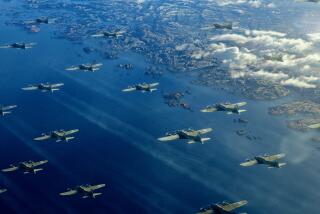Navy Helps Film Crews Ensure All Is Shipshape
POINT MUGU — For a Hollywood film crew, Hangar 34 is heaven.
The place is full of giant NP-3D Orion airplanes and Navy crew members busy tinkering on aircraft engines. The buzz of activity has attracted crews from the military television show “JAG” to film in this hangar at Point Mugu’s Naval Air Station.
Ventura County’s two Navy bases--the Naval Air Station and the Naval Construction Battalion Center in Port Hueneme--have become increasingly popular with Hollywood film crews because of their proximity to Los Angeles.
The two bases provide “visually almost everything we need for the show,” said Bill Webb, a camera operator for “JAG” who was reveling at the prospect of pointing his lens at real sailors, planes and ships.
The bases have served as a backdrop for such popular military films as “A Few Good Men” and “Flight of the Intruder.” More recently, film crews used the facilities for the upcoming pictures “Perfect Storm” and “U-571,” a World War II submarine movie. This summer, the bases will be used for another World War II film, Disney’s “Pearl Harbor.” “JAG” has used the two bases about half a dozen times.
Lt. Tanya Wallace of the Los Angeles-based Navy Office of Information gets constant phone calls from location scouts hoping to tap real Navy life for their military films. They want the atmosphere of a Navy operation that can’t be replicated on a studio sound stage.
“They don’t have to create this whole hangar,” Wallace said recently, waving at a bevy of military equipment where a “JAG” crew prepared to shoot a scene. “They just walk in and start filming.”
When Hollywood types converge on the bases, the result is a melding of two very different cultures with very similar work ethics. On one side of Hangar 34, film crews work all day in the shadow of looming NP-3D Orions, large surveillance planes used during missile tests. On the other side, Navy crews hustle to keep those planes ready to fly. One crew entertains the country; the other protects it.
That dichotomy has led to a mutual respect between the Navy and its film-industry guests.
“I think the military gets a greater appreciation for the long hours that [film crews] work,” Wallace said.
The “JAG” crew, likewise, has been wooed by the Navy’s cooperative spirit. That can mean moving planes to make a scene look better or providing sailors to appear as extras.
“JAG” has filmed at bases from San Diego to San Francisco, but the Ventura County facilities have been notably cooperative, Webb said.
The bases were a pleasant surprise for Henric Nieminen, the visual effects coordinator for “U-571.” The movie’s crew used the Naval Construction Battalion Center to test one of its five model submarines. Nieminen wanted to know how his 5,000-pound, mini-submarine model would fare in the open seas and how it would look on camera.
The film’s crew was first attracted to the base because of the Navy’s openness and hospitality, he said, but quickly discovered the port was full of equipment that made its job easier.
“We just provide things that civilian locations cannot provide,” Wallace said.
In a business where millions of dollars can change hands in a blink, the Department of Defense precludes the Navy from making money on studios that use its facilities. Instead, studios reimburse the bases only for expenses, which can include everything from jet fuel to man-hours.
“We’re not in the business of making money off of movies,” Wallace said.
What the Navy really wants out of the deal is good public relations, Wallace said.
“This is by no means a way of gaining money,” she said. “We just want a real positive reinforcement of the Navy.”
This can simply mean portraying the military realistically to the public. Officials have turned away films based on unrealistic scripts, Wallace said, although she declined to give examples. But the Navy has shared its facilities with crews using scripts that are “less than flattering” to the Navy. For example, shows with plots in which sailors make poor decisions and face court-martial have been filmed at Navy facilities, she said.
“Our service is not flawless,” Wallace said. “We want a reality-based show.”
Navy spokeswoman Teri Reid said Wallace has been known to watch film crews like a hawk. When a female actress’ hair didn’t meet Navy regulations, Wallace reminded wardrobe crew members to make sure it did. During a recent filming of “JAG,” Wallace pointed to two extras pretending to work on a plane engine, noting they were wearing the proper headgear.
The Navy also provides research to screenwriters, who often call officials for advice.
The process can be monotonous--even when the fruits of research are burned onto film. At Hangar 34, “JAG” actors rehash their lines repeatedly in the morning’s cold; crew members haul gear around the hangar, stringing electrical cord behind them.
There is also a lot of excitement. A throng of naval personnel gawks from a balcony. Others mill about hoping to be chosen as extras.
“It’s kind of a sleepy little base,” said Lt. Dan Harwood, who was picked to appear in an upcoming “JAG” episode. “A little publicity and a little action on the base is a good thing.”
But Navy life doesn’t stop just because Hollywood happens to take over an airplane hangar. A naval officer plucked his subordinate from a crowd of onlookers and chided: “This isn’t Universal Studios. Come with me.”
Others continued to take in the view of the film crew before returning to work. Some watched in silent awe; others seemed nonplused.
“In the Navy, you kind of do weird things,” said Lt. P.J. Trudell, who couldn’t wait to tell his mom that he would appear on the show. “And this is one.”
More to Read
The biggest entertainment stories
Get our big stories about Hollywood, film, television, music, arts, culture and more right in your inbox as soon as they publish.
You may occasionally receive promotional content from the Los Angeles Times.










